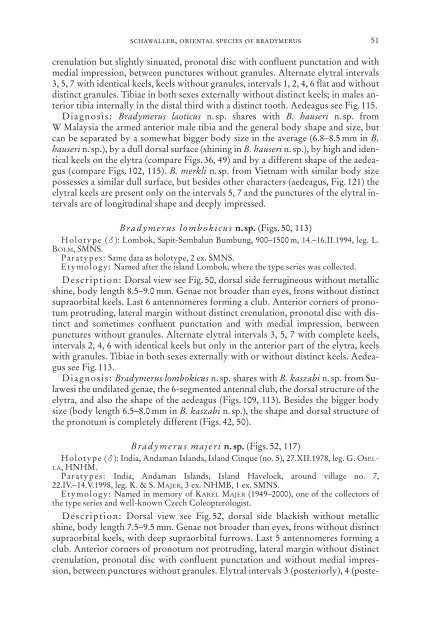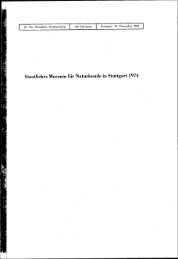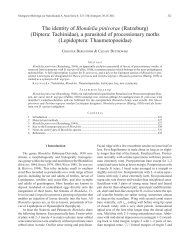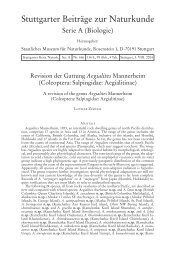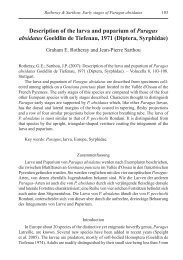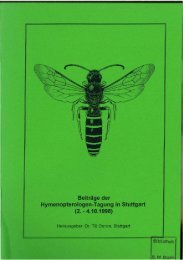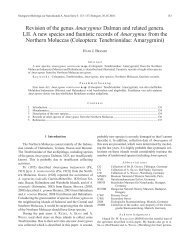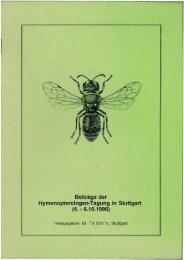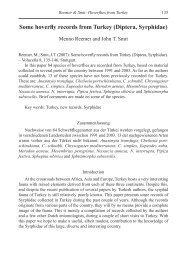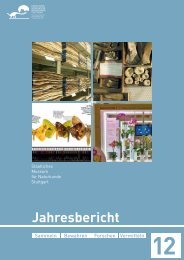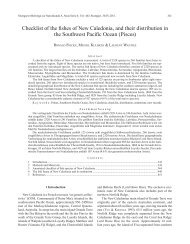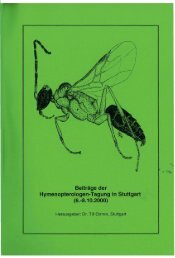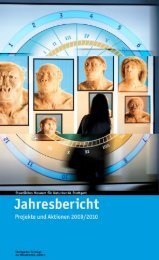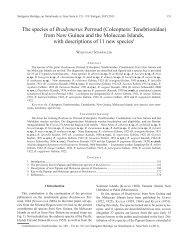Serie A (Biologie) - Staatliches Museum für Naturkunde Stuttgart
Serie A (Biologie) - Staatliches Museum für Naturkunde Stuttgart
Serie A (Biologie) - Staatliches Museum für Naturkunde Stuttgart
Create successful ePaper yourself
Turn your PDF publications into a flip-book with our unique Google optimized e-Paper software.
Bradymerus majeri n. sp. (Figs. 52, 117)Holotype (): India, Andaman Islands, Island Cinque (no. 5), 27.XII.1978, leg. G. OSEL-LA, HNHM.Paratypes: India, Andaman Islands, Island Havelock, around village no. 7,22.IV.–14.V.1998, leg. K. & S. MAJER, 3 ex. NHMB, 1 ex. SMNS.Etymology: Named in memory of KAREL MAJER (1949–2000), one of the collectors ofthe type series and well-known Czech Coleopterologist.Description: Dorsal view see Fig. 52, dorsal side blackish without metallicshine, body length 7.5–9.5 mm. Genae not broader than eyes, frons without distinctsupraorbital keels, with deep supraorbital furrows. Last 5 antennomeres forming aclub. Anterior corners of pronotum not protruding, lateral margin without distinctcrenulation, pronotal disc with confluent punctation and without medial impression,between punctures without granules. Elytral intervals 3 (posteriorly), 4 (posteschawaller,oriental species of bradymerus 51crenulation but slightly sinuated, pronotal disc with confluent punctation and withmedial impression, between punctures without granules. Alternate elytral intervals3, 5, 7 with identical keels, keels without granules, intervals 1, 2, 4, 6 flat and withoutdistinct granules. Tibiae in both sexes externally without distinct keels; in males anteriortibia internally in the distal third with a distinct tooth. Aedeagus see Fig. 115.Diagnosis: Bradymerus laoticus n. sp. shares with B. hauseri n. sp. fromW Malaysia the armed anterior male tibia and the general body shape and size, butcan be separated by a somewhat bigger body size in the average (6.8–8.5 mm in B.hauseri n. sp.), by a dull dorsal surface (shining in B. hauseri n. sp.), by high and identicalkeels on the elytra (compare Figs. 36, 49) and by a different shape of the aedeagus(compare Figs. 102, 115). B. merkli n. sp. from Vietnam with similar body sizepossesses a similar dull surface, but besides other characters (aedeagus, Fig. 121) theelytral keels are present only on the intervals 5, 7 and the punctures of the elytral intervalsare of longitudinal shape and deeply impressed.Bradymerus lombokicus n. sp. (Figs. 50, 113)Holotype (): Lombok, Sapit-Sembalun Bumbung, 900–1500 m, 14.–16.II.1994, leg. L.BOLM, SMNS.Paratypes: Same data as holotype, 2 ex. SMNS.Etymology: Named after the island Lombok, where the type series was collected.Description: Dorsal view see Fig. 50, dorsal side ferrugineous without metallicshine, body length 8.5–9.0 mm. Genae not broader than eyes, frons without distinctsupraorbital keels. Last 6 antennomeres forming a club. Anterior corners of pronotumprotruding, lateral margin without distinct crenulation, pronotal disc with distinctand sometimes confluent punctation and with medial impression, betweenpunctures without granules. Alternate elytral intervals 3, 5, 7 with complete keels,intervals 2, 4, 6 with identical keels but only in the anterior part of the elytra, keelswith granules. Tibiae in both sexes externally with or without distinct keels. Aedeagussee Fig. 113.Diagnosis: Bradymerus lombokicus n. sp. shares with B. kaszabi n. sp. from Sulawesithe undilated genae, the 6-segmented antennal club, the dorsal structure of theelytra, and also the shape of the aedeagus (Figs. 109, 113). Besides the bigger bodysize (body length 6.5–8.0 mm in B. kaszabi n. sp.), the shape and dorsal structure ofthe pronotum is completely different (Figs. 42, 50).


